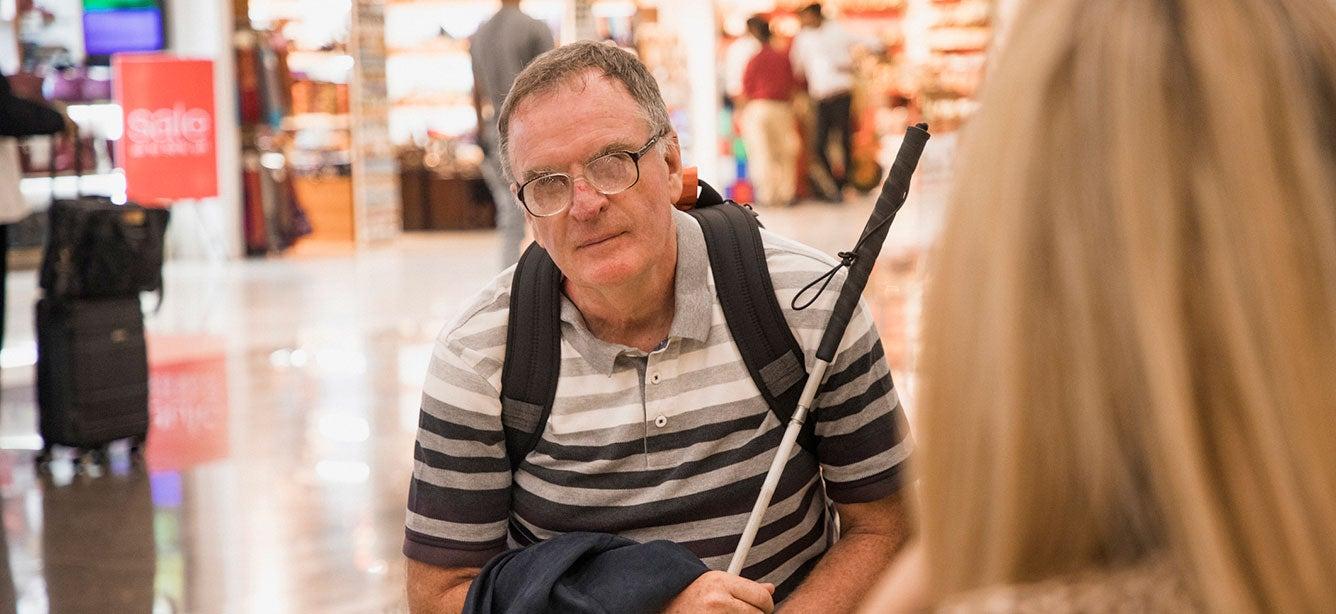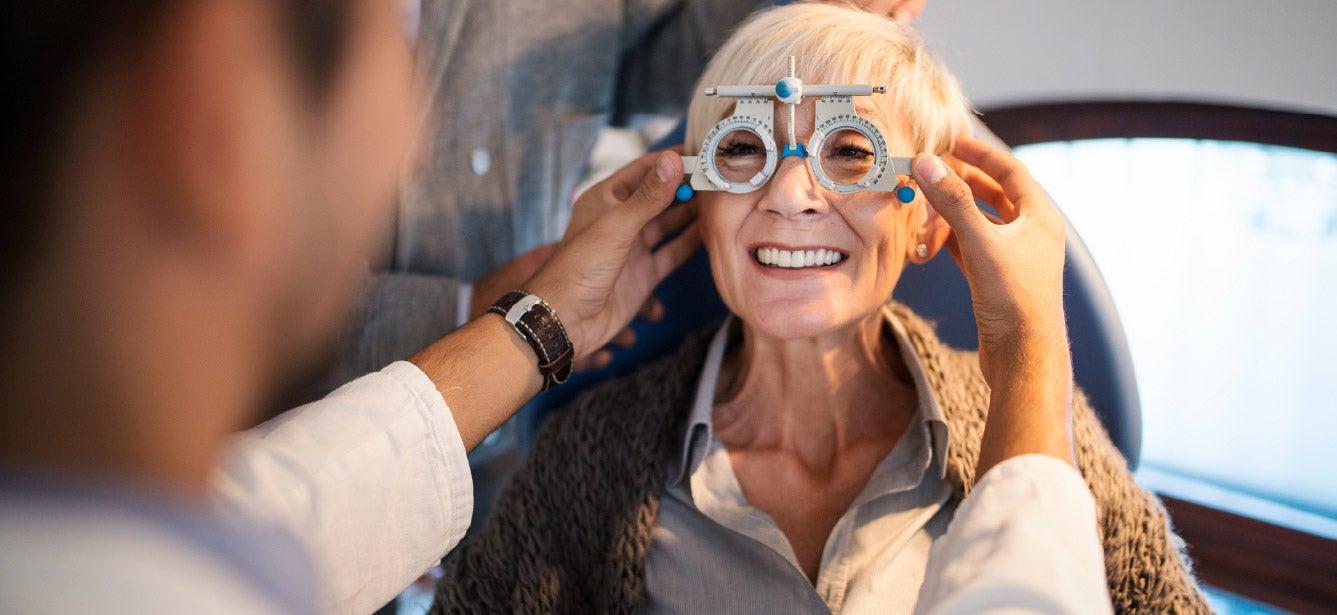Supporting Adults from Diverse Backgrounds Who Are Living with Vision Loss
8 min read

Research and experience confirm that blindness and low vision can dramatically impact the quality of life and health of the adults you support. And it's important to understand how demographic factors, including socioeconomic status, ethnicity, race, geography, age, language, and cultural nuances, affect access to health care, resources, and improved quality of life.
To more fully understand the impact of vision loss across all social determinants of health, VisionServe Alliance, in partnership with The Ohio State University College of Optometry, developed the Big Data Project Reports for Adults 65+.1 These reports were developed using Behavioral Risk Factor Surveillance System (BRFSS) data, and American Community Survey (ACS) US Census Bureau data.
Historic in scope and reach, the National Big Data Project Report found that 7.3% of US adults 65 and older report blindness and low vision. As the population continues to age, that number is projected to increase significantly. Since age-related eye diseases can lead to vision loss, blindness and low vision are more prevalent among older age groups: 6.3% of people age 65-74 report blindness and low vision compared to 9.8% of those age 80 years and older.
How does vision loss prevalance vary?
The prevalence of vision loss nationally varies across demographic groups. When asked the question “Are you blind or do you have serious difficulty seeing even when wearing glasses?” 7% of males and 7.5% of females reported vision loss.
Vision loss among adults 65+ varies more dramatically by race and ethnicity:
- White (non-Hispanic)—6.1%
- Black (non-Hispanic)—10.5%
- Asian—8.8%
- Hispanic—13.9%
- American Indian or Alaskan Native—14.2%.
Some in these groups are also at greater risk for developing age-related eye diseases such as diabetic retinopathy and glaucoma and may face barriers to eye care. Disparities in health care access, whether due to language, reduced or non-existing insurance coverage, or cultural nuances, can impact and delay diagnosis and treatment.
Factors including poverty and reduced education also contribute to a higher prevalence of chronic health conditions and poorer health-related quality of life. Adults 65+ with blindness and low vision have lower levels of education and income than those without blindness and low vision. For example, more than one-quarter of adults 65+ with blindness and low vision (28.7%) have not graduated from high school, and 37% have annual incomes below $20,000.
Identifying cultural barriers
Language barriers and cultural factors can further impact the accessibility of information, compounding underlying accessibility issues often faced by adults with vision loss who struggle to access documents, portals, and other vital outlets. Fortunately, an increasing number of facilities are providing materials in multiple languages. Likewise, enhancing accessibility for those with vision loss is vital, with more practices offering, or considering to offering, content in Braille and large print formats.
“Health literacy” may also vary widely by group and can dramatically affect an individual’s ability to understand a broad range of health-related information—impacting treatment decisions, choice of services, health-related outcomes, and long-term quality of life.
Tracking the geographic impact of vision loss
The Big Data Project Reports revealed that blindness and low vision are not evenly distributed across the US. States with a higher proportion of older people and racial and ethnic minorities have a greater prevalence of vision problems.2
There is wide variation in the prevalence of blindness and low vision from state to state. For example, of eight states initially examined, Louisiana reports the highest prevalence of blindness and low vision at 12.4%, with Illinois reporting the lowest prevalence at 5.8%. Patterns of blindness and low vision among racial and ethnic minorities likewise vary from state to state. For African Americans, the prevalence of blindness and low vision ranges from 7.1% (New York) to 19.3% (Louisiana). The prevalence of blindness and low vision among Hispanics ranges from 4.2% (Missouri) to 27% (Louisiana).
Adults with vision loss more likely to live with chronic conditions
Compared to their peers without vision loss, adults 65+ with vision loss are much more likely to face age-related chronic health conditions. Among adults 65+:
- 16.9% with blindness and low vision report having had a stroke, compared to 7.3% of those without blindness and low vision. While a stroke often compromises vision, the effects of vision loss from stroke are often unrecognized, under-appreciated, and untreated.
- 36.4% of older people with blindness and low vision report diabetes, compared to 22.1% of those without vision loss.
- 17.2% of those with blindness or low vision report having had a heart attack, compared to 10.2% among their peers without vision loss.
- 51% of those with blindness or low vision report fair or poor health, more than double those without vision loss at 23%.
- More than double the percentage of those with blindness or low vision reported 14 or more days of poor physical health in the past 30 days: 36% compared to 16% among those without blindness and low vision.
Vision loss, depression, and hearing loss
Because blindness and low vision often compromise daily activities and increase isolation, people 65+ with blindness and low vision report depression at nearly twice the rate of those without blindness or low vision: 26.9% compared to 13.9%. Similarly, 18% of people with blindness or low vision report 14 or more days of poor mental health, compared to 7% of those without blindness and low vision. This disparity in quality of life is repeated in activity limitation days: 34% of people with blindness and low vision report 14 or more days of activity limitation, compared to 19% among those without vision loss.
Older adults with vision loss also report hearing problems at more than twice the rate: 33.3% compared to 15% of people without blindness and low vision. Dual sensory impairment can have a compounding effect leading to complex healthcare and rehabilitation needs. Vision and hearing are often addressed Independently, when combination interventions could be more effective.
Addressing the higher falls risk for older adults with vision loss
Nearly half (47%) of older adults in the US with blindness or low vision report falling, compared to 28% of those without vision loss.3 Addressing this debilitating hazard through falls prevention interventions along with orientation and mobility training can prevent related complications and diminished quality of life.
The National Council on Aging provides vital falls prevention information that you can share with the adults you support, such as this article highlighting a team approach, including professionals like you! Since adults with vision loss face unique risks for falls, take a look at another recent article providing safety tips for adults living with vision loss.
Addressing challenges and changing lives
Significant vision loss can make common activities such as climbing stairs, crossing a street, using public transportation, and performing household chores difficult or impossible. Older adults experiencing blindness and low vision may have difficulty managing accounts, paying bills, and identifying prescribed medications. Falls or fear of falling may further curtail their independence.
Blindness and low vision often cause isolation, with people spending more solitary time at home and less time with family and friends. Although support groups can help, many older people with blindness and low vision do not interact with other blind and low-vision people, creating further isolation and depression.
Yet while the circumstances and risk factors associated with aging, blindness, and low vision are serious, there is a lot we can do to improve these lives in transition.
Providing greater access to vision and eye health, increasing availability of vision rehabilitation services, and promoting self-reliance can help older people live independently and remain active in their community.
Responding to each client’s uniquely complex circumstances requires thoughtful, innovative, well-integrated strategies by multiple entities. These include eye-care providers, the aging services network, public health, transportation and housing professionals, and comprehensive vision rehabilitation services. Increasing insurance coverage for eye care, treatments, and low vision aids through Medicare, Medicaid, and other public and private health programs is essential.
Restoring hope through vision rehabilitation
A network of public and private vision rehabilitation agencies forms the nucleus of support for older people with blindness and low vision. Vision rehabilitation addresses communication, daily life, personal care and wellness, self-advocacy, travel, and mobility skills by implementing tools including assistive technology (e.g., smart phones, tablets, and computers). Vision Rehabilitation services often include counseling, education, and referrals to community resources. People living with blindness and low vision benefit from peer support groups, where they can share common experiences and exchange information about successful management strategies.
Learn more about vision rehabilitation and how to connect your blind and low-vision clients to these life-changing services. Depending on the level of a client’s vision loss, many services may be provided at no cost.
Most vision rehabilitation services begin with low vision evaluations and providing assistive vision devices. Often conducted in the client’s home or in an agency setting, additional vision rehabilitation services improve independence, self-esteem, mental and physical health, and quality of life.
Visit Time to Be Bold to locate your area's vision rehabilitation services and other crucial resources. Connect clients with the APH hotline to speak with someone about support and access practical coping strategies for everyday tasks, remote discussion groups, and free online resources at the APH Connect Center and VisionAware.
Sources
1. VisionServe Alliance. United States’ Older Population and Vision Loss: A Briefing, St. Louis. 2022. Report content reproduced in this article with permission. Big Data Report Project information and national and state reports published to date are found on the internet at visionservealliance.org/big-data-project-insights
2. Varma, R., et al. Visual impairment and blindness in adults in the United States: demographic and geographic variations from 2015 to 2050. JAMA Ophthalmology. July 2016. Found on the internet at https://pubmed.ncbi.nlm.nih.gov/27197072/
3. Crews, J.E., et al. 2016. Falls among persons aged≥ 65 years with and without severe vision impairment—United States, 2014. Morbidity and Mortality Weekly Report. May 6, 2016. Found on the internet at https://www.cdc.gov/mmwr/volumes/65/wr/mm6517a2.htm



